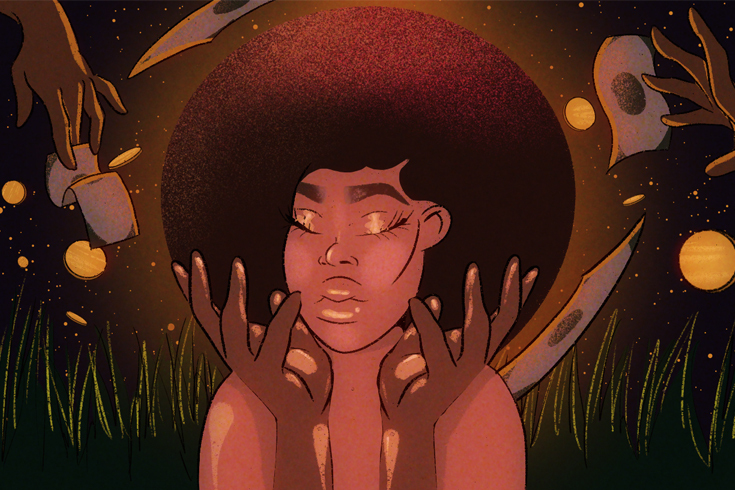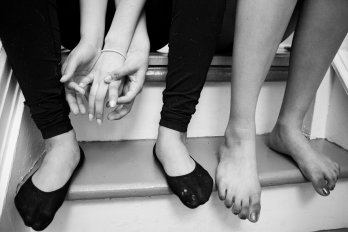There aren’t, compared to Ontario and Quebec, that many Black people in British Columbia: less than one-tenth of the overall Black Canadian population. But, when troubles—like, for instance, a global health crisis—strike, official numbers don’t matter. An ongoing calamity—anti-Black racism—becomes an acute emergency. So, as covid-19 began to take hold, a group of activists and organizers did something that, for Black folks, is as old as time: they started a mutual-aid group.
Listen to an audio version of this story
For more audio from The Walrus, subscribe to AMI-audio podcasts on iTunes.
“Our community members are likely to be found in the blind spots of the [federal] agencies that are giving out the money,” says Kevonnie Whyte, one of the group’s organizers. The money the group has collected has gone to Black migrants without permanent residency, Black students stuck in Canada on visas that limit their ability to work, and Black people trapped in the rinse cycle of the gig economy—taxi drivers, delivery couriers, cleaners, and dog walkers. The premise of the fund is simple: for the duration of the pandemic, any Black person in BC can apply to get $150 to use for whatever they need. The fund prioritizes Black people who, for whatever reason, don’t get access to government supports like the Canada Emergency Response Benefit.
In the dawning days of the pandemic, when people were stress-baking and becoming amateur epidemiologists, grassroots organizations and ad hoc community efforts sprang up all over. A group of young women in Boston started a mutual-aid drive to get help—cash, food, assistance—to the vulnerable in their community. Students at Pittsburgh’s Carnegie Mellon University started spreadsheets to help people cover basic expenses. You could give your cash to a GoFundMe for Canadian movie-theatre workers. The Toronto chapter of Black Lives Matter launched a mutual- aid fund for the city’s Black community. Someone started a Google Doc to keep a running list of fundraisers to support sex workers all over the world. And, by late May, Whyte says, the Black in BC Mutual Aid collective had raised nearly $20,000 and had disbursed three-quarters of that to over 100 people. Thinking back on it, she laughs. “We were proud of that.”
Then, in June, everything changed. In the aftermath of the killing of George Floyd, the group received an astounding influx of donations, quintupling their fund in ten days to over $100,000; by early July, they had topped $170,000. “It’s unfortunate that death and police brutality . . . are what motivated people to contribute to our fund,” Whyte says. “But, at the same time, the contributions are happening. It’s a mix of feelings.”
And that, in a way, is a capsule history of mutual aid. Whyte and her coorganizers in BC saw a coming danger for Black people and proactively created a community network to head off some of the worst effects; others noticed how dangerous the world is for Black people after it was too late and well after Black people had already started helping themselves. Over decades and centuries, mutual aid has helped people pay rent, buy groceries, and acquire medicine; it has given workers something where there is so much nothing to be had, and it has given luckier people a way to help out in desperate times.
So why weren’t we doing mutual aid before—everybody, all the time? Well, Black people were.
Mutual aid is not new. It’s a long-standing practice of Black communities. “Mutual aid is just something that we’ve always done,” says Caroline Shenaz Hossein, a professor in York University’s social science department. “Crowdfunding, the sharing economy—I mean, these are all these nicknames that white people come up with to make it look like it’s new, and it’s never new.”
In the late aughts, Hossein’s research took her to the Caribbean, where she met the “banker ladies”: women who ran and participated in money pools. Money pools are deeply familiar to many people from Black diasporas. Your moms and aunties get together, they cackle loudly for a couple of hours, and later, your mother says not to worry, you will be going to university. There’s a magical quality, money appearing as if from nowhere.
Depending on where you’re from and who invited you in, the pools have different names: sol (Haiti), susu (Ghana), box hand (Guyana), jama (Kenya), hagbad (Somalia). There are cultural nuances in how you get into one, and the amounts may range, but the principle is almost universally the same—you get out what you put in. A typical arrangement might look like this: ten women decide to each contribute $30 a month to a pool, and they each get their turn receiving money from the pool—a $300 cash injection when they do. What enslaved people in Haiti and elsewhere knew is not too distant from the wisdom of Somali mothers and Grenadian aunties: if everyone gives, everyone gets.
The money, as useful as money can be, is almost beside the point. Mutual aid is a reciprocal experience; once welcomed, you’re now in a community of giving, with all the joys and burdens that entails. For Ginelle Skerritt, the executive director of the Warden Woods Community Centre, in Toronto, joining her mother and aunts in their susu as a young person meant more than having some extra money for school. “I felt like I was a woman; I felt like I was doing things that big people do,” she says.
Skerritt now runs a susu network with different groups of varying levels of investment and community interaction—a recent return to the world of money pools after running one in the 1990s. (Though the principles have stayed the same, the technology has changed: when she ran her first one, the members gave cheques; now, it’s all done via e-transfer.) The infusion of money from that first family-based susu helped pay off her student loans. “That doesn’t sound too terribly sexy,” she says, “but it was such a relief. It paved the way for me to be able to do other things with money in my thirties.”
I1932, at the height of the Great Depression, Black people in Gary, Indiana, developed a local economy though mutual aid. “The last bank had just pulled out of their neighbourhood. Everybody was unemployed,” says political economist Jessica Gordon-Nembhard. The way she tells it, they didn’t know exactly what to do. Maybe, they thought, we could start a co-op for groceries or just to share what little we do have. Twenty African American families joined a study group; for a year and a half, they met monthly to talk and plan, chaired by a local high school teacher, Jacob L. Reddix, with a passion for cooperative economics. (A cooperative economy is one in which “most of the economic activity is organized around cooperative ownership . . . in a democratic way so that they all participate in decision making about the economic activity,” Gordon-Nembhard explains.)
Eventually, they pooled enough money ($24 at first) to buy their groceries in bulk. Next came a credit union. Within five years, the area added a gas station and two branches of a co-op grocery store, and at the school, they began to teach a curriculum on cooperative enterprises. In the middle of a depression and despite the continued closure of the steel mills, the Consumer’s Cooperative Trading Company was bringing in $160,000 (US) in sales and had a membership in the hundreds. The title of their agenda—“A Five Year Plan of Cooperative Action for Lifting the Economic Status of the Negro in Gary”—was precise: in good times and bad, the people must prosper with the economy, not after.
In her book Collective Courage: A History of African American Cooperative Economic Thought and Practice, Gordon Nembhard documents how, during slavery, enslaved people would pool their resources to plant and farm gardens, create burial societies, and take care of widows and children. In the years after slavery was abolished, mutual-aid groups would work together to build wealth by pooling resources to buy tractors, land, and feed. In Tennessee, the Nashoba Commune (founded in 1825) brought Black people in the United States together in the pursuit of literal freedom; a century later, groups like the Depression-era People’s Consumer Cooperative did the same in pursuit of economic equity.
Contemporary money pools are part of this long legacy of collaborative financial planning and support. “It’s really a savings vehicle,” says Skerritt of the susu network she runs. She asks the members to share through email what they’re saving for so they can help one another meet their goals; a donation option allows members to contribute a portion of the money they put into the pool to charity. “There’s also been talk about using it to launch ideas around buying property together or investing in real estate together.”
Regardless of what they decide, she says, the goal is the talking, which builds trust and helps dispel trepidation about managing finances. Cooperative economics invests trust in people through time and conversation and sharing instead of through cash and credit. “The Underground Railroad was a cooperative movement,” says Hossein. “That was a network of people coming together through mutual aid.” Its informality was built-in: it was too dangerous to talk about, let alone formalize. Who would—or even could—go to a bank to say, “I’d like to save this money so that I can free some slaves in the morning”?
Who, in this anti-Black world, do you trust?
Hossein says that fear of discovery persists in the money pools that operate today. In the Caribbean, she had no issues when researching box hands, susus, and partners. But, in Canada, it’s a different story. Some people find that talking mutual aid is met with suspicion: How can people have money if they are poor? And, if they have so much money, why are they still poor? For others, explaining one’s culture becomes an argument. Better, then, not to talk too much about it. The banker ladies here, she says, “they hide what they do. . . . They keep these things under wraps.”
In a 1902 essay, political theorist Pëtr Kropotkin describes embarking on a quest to observe Darwinian competition in a field excursion with a zoologist friend. But what they find is not so much an endless fight for survival as untold collaboration. From ants to crabs to birds to beetles, Kropotkin sees far less of the heated rivalry for resources he was expecting and instead something rather more cooperative. In the essay, which he titled “Mutual Aid: A Factor of Evolution,” he writes: “Mutual aid within the community, self-devotion grown into a habit, and very often self-sacrifice for the common welfare, are the rule.”
But the behaviour of eagles on a Russian mountainside can’t entirely explain why people help one another. Kropotkin understood mutual aid as a global, biological phenomenon strictly for day-to-day survival. But that view limits its political power. In Canada, the liberal Catholic Antigonish movement brought together farmers and fishermen, around kitchen tables in the Atlantic provinces, to help them push back against the expansion of corporate fishing. In Quebec, caisses populaires (a form of credit union begun by farmers) are celebrating nearly 120 years of existence.
And yet, despite these well-known examples, there are few banking systems in Canada that recognize the specific ethnic economic activity of mutual aid. My mother’s jama, which gives money when Kenyans in Canada have to pay funeral and travel costs back home, had to undertake a labyrinthine process to establish a bank account. First, most banks said no. Then, a bank manager decided that they could qualify as a community group. But, in order to “become” a community group, they had to draft documents—a constitution with bylaws, a board of directors, meeting minutes. The Black culture of survival requires paperwork to be understood. How do you contain decades of community survival in a document that a bank understands?
Some don’t. My mother and my aunties are the lucky ones. Hossein has spoken to Somali women who allege they’ve had their hagbad money taken during police raids of their neighbourhoods. “Because there’s no understanding of these women’s mutual aid. There’s not even an imagination that these women could be pooling honest money, from driving a bus or cleaning someone’s house, to help one another.”
The suggestion of illegality has haunted Black mutual aid going back to fugitive former slaves on the Underground Railroad. The anxiety of being discovered, of hiding what you’ve earned and given, and of not being understood means few communities want to talk about it, especially communities that are criminalized. It’s not just money; it’s a practice of trust.
What’s a funeral without food? And singing? And catching up?” laughs my mother when I tell her she always seemed to be on the way to another late-night funeral party. “There’s a lot of partying, depending on whether there’s beer. Or it is a Seventh Day Adventist one—then you go with your own wine in a pocket or in a bag.”
When my grandmother passed away, three years ago, my parents held a lightly raucous memorial in their backyard. My many not-quite-related-but-definitely family aunts and uncles kept asking for supplies. They’d come to commiserate, and they’d also come with cards filled with cash. But no envelopes or pens. Of course, I had fresh packs of both on me. I know this process like I know a good cup of tea from Kenya’s Kisii Highlands. I am steeped in mutual aid, endlessly warmed by community and reciprocity.
In addition to the cash, the money from my parents’ bereavement group helped pay for hospital fees, which, in Kenya, must be paid before a body is released. “We bought the coffin and hired the hearse to take the body home,” says my mom. “Without that money, we would have to be in debt.” My parents are immigrants whose careers started well after their Canadian-born contemporaries’; debt is a fraught burden and savings are thin.
What they have instead—what we have—is a habit formed by time, urgency, community, history, and a need to survive together. If something happens to you, my mom says, you learn that you don’t have a preexisting support system here. “You don’t have anybody. These are the people in the community who are going to help you out.”




